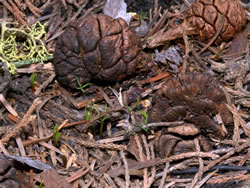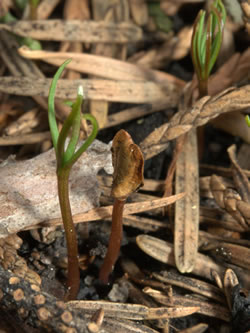National Cohesive Wildland Fire Management Strategy Success Story
The Littlest Sequoias: The Bobcat Prescribed Fire a Year Later
Sequoia and Kings Canyon National Parks, California
Cohesive Strategy - Maintain and Restore Landscapes
2011

These young seedlings were only a few weeks old when this photo was taken. Photo by Tony Caprio.

The seed is still attached for one of sequoias at this stage. For scale, the seed is about the size of a piece of oatmeal. Photo by Tony Caprio.
The 97-acre Bobcat Prescribed Fire was completed in June, 2010. The main objective of this project was to reduce the fuels and to encourage giant sequoia regeneration. Visits to the project area prove that these fire ecology and restoration objectives were met.
Walking through the area today provides an exciting highlight. Sequoia seedlings can be found throughout the forest for those with a trained and observant eye. For the parks, it demonstrates the effectiveness of prescribed fires in giant sequoia groves. These seedlings, which sprouted during summer 2011, are now just a few months old.
“It’s fulfilling to see that restoring fire to this landscape helps promote the regeneration of our namesake species,” said David Bartlett, Fire Management Officer for the parks. “It makes you think about how natural fires functioned here over the years.”
Giant sequoias are fire adapted and thrive in naturally cycling fire. Fire opens the cones, and releases the tiny seeds to the nutrient rich ash and mineral soil below—ideal conditions for this tree’s germination. Fire thins competing vegetation and trees and opens the canopy for this sun-loving species.
Natural fire occurs about every 10-15 years in a sequoia forest. Since this area had experienced fire in 1984 and 1988, it was restored to its natural fire regime. Fire behavior was excellent with denser pockets of fuels being consumed while wetter areas or areas with less fuel did not burn.
For visitors last year, the opportunity to see fire as something that belonged in the forest and helped create sequoia saplings was a highlight of their visit. However, the story of this project continues with a new generation of sequoias as a result of this project. Which of the seedlings will grow into maturity? Future visitors will see how this story continues.
Contact
Deb Schweizer, Fire Education Specialist
Email: Debra_Schweizer@nps.gov
Phone: (559) 565-3703
Keywords: Fire Ecology and Restoration